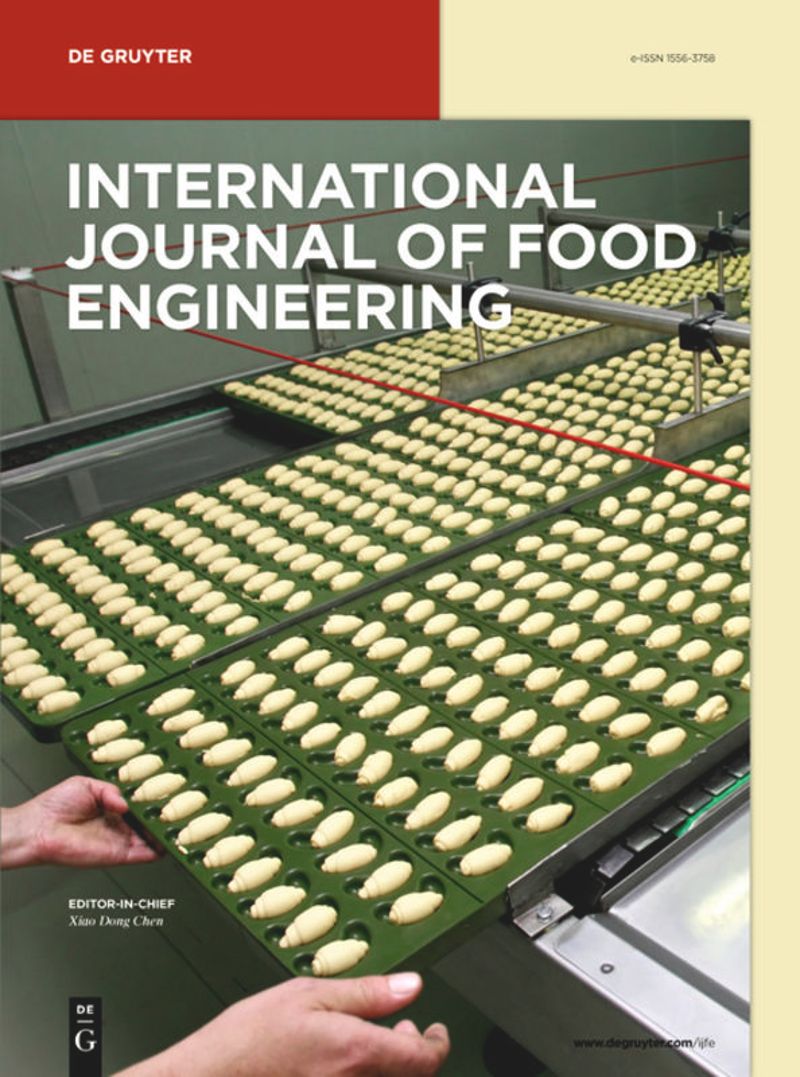Effect of defatted rice bran addition on properties of texturized soy and rice protein products
IF 1.4
4区 农林科学
引用次数: 0
Abstract
Abstract The objective of this work was to produce low moisture-texturized vegetable protein (LM-TVP). Firstly, SPI:DRB at ratio of 50:50, 65:35 and 80:20 (w/w) was blended to produce TVP with 50–70 % protein (TSP50–70), respectively. In addition, RPI:DRB was also blended at the same ratio to produce non beany odor TVP with 50–70 % protein (TRP50–70). All samples were extruded using twin screw extruder. Extrusion condition was fixed at 25 % of feed moisture, 400 rpm of screw speed and 130 °C of die temperature. Next, properties of TSP50–70 and TRP50–70 before and after rehydration were characterized. For TSP50–70, studied properties consisting of expansion ratio, density, WAC, WHC and OHC of TSP50–70 were 2.20–2.27 %, 0.26–0.34 kg/m3, 414–446 %, 2.87–4.88 g H2O/g and 2.55–2.73 g oil/g respectively. These properties values were closed and in the same range of commercial-TVP (C-TVP). However, texture of TSP50 and TSP70 was significantly different, as decreasing DRB content from 50 (TSP50) to 20 % (TSP70) improved texture in terms of hardness (from 0.51 to 1.88 N), springiness (from 0.73 to 0.96) and cohesiveness (from 0.46 to 0.81) of TSP. Therefore, to add value to DRB, TSP70 (80 % SPI and 20 % DRB) was proposed to produce TSP. For TRP, expansion ratio, density, WAC, hardness, springiness and cohesiveness of TRP50–70 were 1.07–1.34 %, 0.63–0.88 kg/m3, 78–158 %, 1.03–9.10 N, 0.71–0.85 and 0.27–0.29 which were out of range compared to C-TVP.脱脂米糠添加量对大豆和大米蛋白质地化产品性能的影响
摘要本工作的目的是生产低水分质地化植物蛋白(LM-TVP)。首先,将SPI:DRB按50:50、65:35和80:20(w/w)的比例混合,以生产50-70的TVP % 蛋白(TSP50-70)。此外,RPI:DRB也以相同的比例混合,以产生50–70的无豆腥味TVP % 蛋白质(TRP50-70)。所有样品均使用双螺杆挤出机挤出。挤压条件固定为25 % 饲料水分,400 螺杆转速rpm和130 模具温度°C。接下来,对再水化前后TSP50-70和TRP50-70的性质进行了表征。对于TSP50–70,所研究的由TSP50-70的膨胀比、密度、WAC、WHC和OHC组成的性能为2.20–2.27 %, 0.26–0.34 kg/m3,414–446 %, 2.87–4.88 g H2O/g和2.55–2.73 g油/g。这些特性值是闭合的,并且在商业TVP(C-TVP)的相同范围内。然而,TSP50和TSP70的质地显著不同,DRB含量从50(TSP50)降低到20 % (TSP70)改善了硬度方面的纹理(从0.51到1.88 N) TSP的弹性(从0.73到0.96)和内聚性(从0.46到0.81)。因此,为了增加DRB的价值,TSP70(80 % SPI和20 % DRB)来产生TSP。对于TRP,TRP50–70的膨胀比、密度、WAC、硬度、弹性和内聚性为1.07–1.34 %, 0.63–0.88 kg/m3,78–158 %, 1.03–9.10 N、 0.71–0.85和0.27–0.29,与C-TVP相比超出范围。
本文章由计算机程序翻译,如有差异,请以英文原文为准。
求助全文
约1分钟内获得全文
求助全文
来源期刊
CiteScore
3.20
自引率
0.00%
发文量
52
审稿时长
3.8 months
期刊介绍:
International Journal of Food Engineering is devoted to engineering disciplines related to processing foods. The areas of interest include heat, mass transfer and fluid flow in food processing; food microstructure development and characterization; application of artificial intelligence in food engineering research and in industry; food biotechnology; and mathematical modeling and software development for food processing purposes. Authors and editors come from top engineering programs around the world: the U.S., Canada, the U.K., and Western Europe, but also South America, Asia, Africa, and the Middle East.

 求助内容:
求助内容: 应助结果提醒方式:
应助结果提醒方式:


